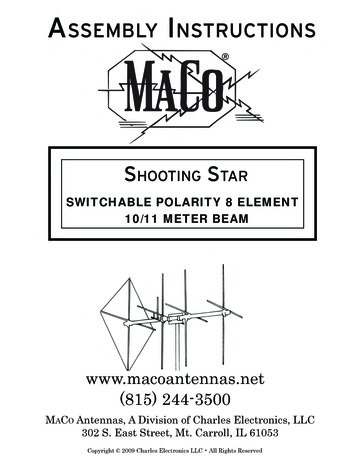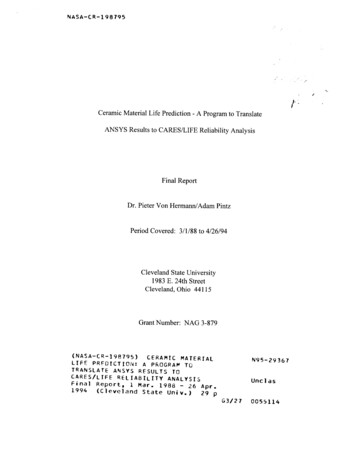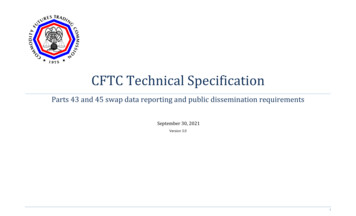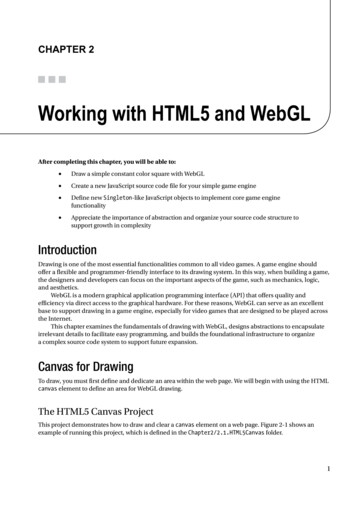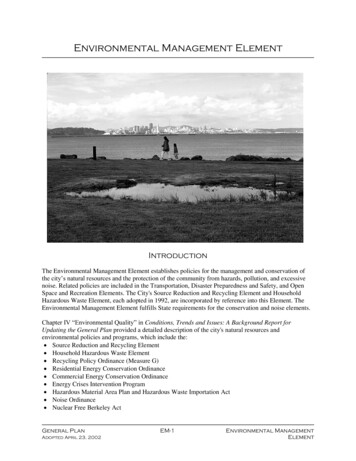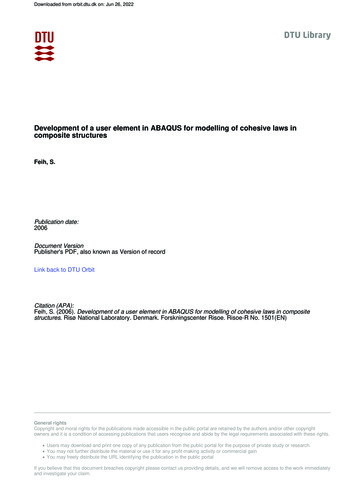
Transcription
Downloaded from orbit.dtu.dk on: Jun 26, 2022Development of a user element in ABAQUS for modelling of cohesive laws incomposite structuresFeih, S.Publication date:2006Document VersionPublisher's PDF, also known as Version of recordLink back to DTU OrbitCitation (APA):Feih, S. (2006). Development of a user element in ABAQUS for modelling of cohesive laws in compositestructures. Risø National Laboratory. Denmark. Forskningscenter Risoe. Risoe-R No. 1501(EN)General rightsCopyright and moral rights for the publications made accessible in the public portal are retained by the authors and/or other copyrightowners and it is a condition of accessing publications that users recognise and abide by the legal requirements associated with these rights. Users may download and print one copy of any publication from the public portal for the purpose of private study or research. You may not further distribute the material or use it for any profit-making activity or commercial gain You may freely distribute the URL identifying the publication in the public portalIf you believe that this document breaches copyright please contact us providing details, and we will remove access to the work immediatelyand investigate your claim.
Risø-R-1501(EN)Development of a user element inABAQUS for modelling of cohesive lawsin composite structuresStefanie FeihRisø National LaboratoryRoskildeDenmarkJanuary 2005
Author: Stefanie FeihTitle: Development ofRisø-R-1501(EN)January 2005Abstract (max. 2000 char.):ISSN 0106-2840ISBN 87-550-3410-1a user element in ABAQUS for modelling ofcohesive laws in composite structuresDepartment: AFMThe influence of different fibre sizings on the strength and fracturetoughness of composites was studied by investigating thecharacteristics of fibre cross-over bridging in DCB specimensloaded with pure bending moments. These tests result in bridginglaws, which are obtained by simultaneous measurements of thecrack growth resistance and the end opening of the notch. Theadvantage of this method is that these bridging laws representmaterial laws independent of the specimen geometry. However, theadaption of the experimentally determined shape to a numericallyvalid model shape is not straight forward, and most existingpublications consider theoretical and therefore simpler softeningshapes. In this article, bridging laws were implemented into aninterface element in the UEL user subroutine in the finite elementcode ABAQUS. Comparison with different experimental datapoints for crack opening, crack length and crack shape show thesensitivity of these results to the assumed bridging law shape. It isfurthermore shown that the numerical predictions can be used toimprove the bridging law fit. One shape with one adjustableparameter then fits all experimental data sets.Contract no.:Group's own reg. no.:16150043-00Sponsorship:Cover :Pages: 52Tables: 3Figures: 26References: 15Print: Pitney Bowes Management Services Denmark A/S,2005Risø National LaboratoryInformation Service DepartmentP.O.Box 49DK-4000 RoskildeDenmarkTelephone 45 46774004bibl@risoe.dkFax 45 46774013www.risoe.dk
Contents1 Introduction52 Mode I bridging law measurement3 Experimental results564 Implementation of the user element 84.1 Background and basic equations 94.2 Unloading 124.3 State variables for the analysis 134.4 Numerical integration 135 Numerical model 145.1 Symmetric half model versus full model: boundary conditions5.2 Application of pure moment bending by displacement control5.3 Bridging law adjustments for numerical modelling 1714146 Numerical results 206.1 Comparison of numerical integration procedures 206.2 Numerical bridging results with finite stress value 216.3 Numerical bridging results with power-law increase 226.4 Adjustment of bridging law 237 Summary29A Implementation of the plane interface elementB Quadratic shape functions and derivativesC Integration points and weights3335D ABAQUS coding for the quadratic line elementE Cohesive element verification3137493
AcknowledgementsI would like to thank Bent F. Srensen for readily available input and suggestions regardingcohesive zone models. A special thanks is going to Lars Pilgaard Mikkelsen for all the helpand discussions about finite element analysis and ABAQUS.4
1 IntroductionFor glass fibre composites, the interfacial properties are controlled by the sizing, which is applied to the glass fibres during manufacture. For the same matrix system, a change of sizingresults in changes of these properties, thereby influencing the mechanical properties such asstrength and fracture toughness. The concept of strength is used for characterising crack initiation in composite design, while fracture toughness determines crack growth and damage development. In mode I crack growth in unidirectional fiber composites, fibre cross-over bridgingoccurs during cracking along the fiber direction. This failure mode plays an important role during delamination of fibre composites and splitting cracks around holes and notches. The fibrebridging zone must be modelled as a discrete mechanism on its own; failure is not just controlled by the cracking at the crack tip. The failure process can be described by a bridging law,which defines the relationship between the crack opening displacement and the local bridgingtractions resulting from the bridging ligaments. Cohesive laws were measured experimentallyin previous work. This report derives the necessary basics and equations to implement theselaws into the commercial finite element code ABAQUS with a cohesive user element. Differentnumerical adjustments of the bridging law are discussed in detail. Crack aspects, such as crackopening shape and the influence of bridging law parameters, are studied based on the numericalresults. It is furthermore of interest to identify the experimental measurements which show thehighest sensitivity with respect to the bridging law shape.2 Mode I bridging law measurementThe approach for the measurements of bridging laws is based on the application of the pathindependent J integral [1], and has been used recently to determine the bridging characteristicsof unidirectional carbon fibre/ epoxy composites [2] and glass fibre composites [3]. A symmetric DCB specimen is loaded with pure bending moments M (Figure 1) under pure mode I.This specimen is one of the few practical specimen geometries, for which the global J integral(i.e. the integral evaluated around the external boundaries of the specimen) can be determinedanalytically [1]:J 12(1 ν13 ν31 )M2b2 H 3 E(1)11E11 is the Young’s modulus referring to the material directions, ν13 and ν31 are the majorand minor Poisson’s ratio, b is the width and H the beam height.Mx2H u*2x12HMFigure 1. DCB specimen with pure bending momentNow consider the specimen having a crack with bridging fibres across the crack faces nearthe tip. The closure stress σ (x2 -direction) can be assumed to depend only on the local crack5
opening δ, i.e. the crack grows in pure mode I. The bridging law σ σ(δ) is then taken asidentical at each point along the bridging zone. Since fibres will fail when loaded sufficiently,we assume the existence of a characteristic crack opening δ0 , beyond which the closure tractionvanishes. Shrinking the path of the J integral to the crack faces and around the crack tip [4]givesJ Zδ σ(δ)dδ Jtip ,(2)0where Jtip is the J integral evaluated around the crack tip (during cracking J tip is equal to thefracture energy of the tip, J0 ). The integral is the energy dissipation in the bridging zone andδ is the end-opening of the bridging zone at the notch root.Connection is made to the overall R-curves as follows. By definition J R is the value of Jduring crack growth. Initially, the crack is unbridged. Thus, by Eq. (2), crack growth initiateswhen JR Jtip J0 . As the crack grows, JR increases in accordance with Eq. (2). Whenthe end opening of the bridging zone δ reaches δ0 , the overall R-curve attains its steady statevalue Jss .The bridging law can be determined by differentiating Eq. (2) [4]. JR(3) δThe applied moment and the end opening of the bridging zone u 2 are recorded. Assuming thatδ u 2 , where u 2 is the notch opening measured at the neutral axis of the DCB specimen(see Figure 1), the bridging law can be determined. This approach models the bridging zone asa discrete mechanism on its own. Contrary to crack growth resistance curves (R-curves), thebridging law can be considered a material property and does not depend on specimen size [2].The test above has been modified with two different bending moments to result in mixedmode testing [5]. In this case, mixed bridging laws can be measured. This has not been undertaken for the current material selection.σ(δ ) 3 Experimental resultsRecently, we have, by the use of a J integral based approach, measured the bridging laws undermode I fracture during transverse splitting of unidirectional glass-fiber/epoxy and glass-fiber/polyester composites with different interface characteristics [3]. With increasing applied moment, crack propagation took place. Fibre cross-over bridging developed in the zone betweenthe notch and the crack tip.JR is calculated according to Eq. (1). The specimen width b was 5 mm with a beam height ofH 8 mm. Assuming that the unidirectional composite is transversely isotropic, the followingelastic composite data were applied for Eq. (1) as previously measured: E 11,epoxy 41.5 GPa,E33 9.2 GPa, E11,polyester 42 GPa, E33,polyester 10 GPa and ν13 0.3 (assumption). Theanalytical function 12δ (4)JR (δ ) J0 Jssδ0was found to fit all experimental data curves of crack growth resistance versus crack openingwell, resulting in curve fits as shown in Figure 2. J0 is the initial value of the experimentalcurve and equal to the fracture energy of the tip during crack growth, while J ss , which isequal to (Jss J0 ), is the increase in crack growth resistance. Sørensen and Jacobsen [2] foundthat the same function fit the data of carbon fibre composite systems well.The experimental values for the bridging laws are given in Table 1. The starting value J 0indicates the point of crack growth initiation and can easily be determined during the experiment. The highest value of 345 J/m2 was observed for the sizing B/ epoxy system. The crack6
2Crack growth resistance [J/m ]600040002000A / epoxyB / epoxyA / polyesterB / polyester00246Crack opening [mm]8Figure 2. Comparison of crack growth resistanceTable 1. Experimental values for the bridging law for different composite systemsComposite systemsizing A/epoxysizing B/epoxysizing A/polyestersizing B/polyesterJ0 [J/m2 ]321 40345 30150 20120 30 Jss [J/m2 ]4000 10003700 5003800 4100δ0 [mm]2.0 0.22.0 0.25.5 5.0initiation value is significantly lower for the sizing B/ polyester system with 120 J/m 2 , whichis also related to a significantly lower transverse strength of not more than half the strength ofthe other composites [3]. In fact, the relation between transverse strength (measured with thetransverse bending test [3]) and crack initiation for the different composite systems is fittedwell by a linear relationship as seen in Figure 3. This verifies the assumption that the crackinitiation value for the DCB test is controlled by the strength of the fiber-matrix bond. It canfurthermore be seen that both axes show about the same ratio low strength and high strengthof nearly a factor 3; however, the transverse bending test results in much lower standard deviations. The higher standard deviation for the DCB fracture initiation is most likely explainedby specimen-to-specimen differences of the manufactured notch, which influences the crackinitiation process.The end opening value δ0 at the onset of steady-state cracking was determined to be 2 mmfor the epoxy systems. For the sizing B/ polyester system, steady-state cracking could not bedetermined with the present specimens, as the fibres continued to bridge the whole length ofthe crack after the maximum measurable notch opening of 5 mm was obtained. Since no upperbound was found for Jss , this bridging behaviour was termed ’infinite toughening’.Differentiating equation (4) results in the bridging law 21 Jss δσ(δ) , for 0 δ δ0 ,(5)2δ0 δ0where Jss is the increase in crack growth resistance due to bridging (from zero to steady statebridging), and δ0 is the crack opening where the bridging stress vanishes.The bridging laws for the different fibre systems are compared in Figure 4. The bridging lawcan be considered a material property [2, 6] and is in an accessible form for implementationinto finite element codes.7
Transverse bending strength [MPa]10075502R 0.8725001002003004002Crack initiation J [J/m ]0Figure 3. Relationship between crack initiation value J0 and the transverse composite strengthfor the different composite systemsBridging stress, σ [MPa]3A / epoxyB / epoxyA / polyesterB / polyester2100246Crack opening [mm]8Figure 4. Comparison of resulting bridging laws4 Implementation of the user elementThere are a variety of possible methods for implementing cohesive laws within commercialfinite element programs. The most versatile is the development and programming of cohesive elements [7–10]. These elements are in most cases defined with zero thickness and prescribe stresses based on the relative displacement of the nodes of the element. Similar work hasalso been undertaken with spring elements (force-opening relation), although in this case theremight be simplifications required when calculating the equivalent nodal spring forces from thesurrounding elements. The procedure is not straight forward when springs are connected toelements with non-linear shape functions, such as 8-noded elements [11].8
4.1 Background and basic equationsFigure 5 shows the interface elements in 2-D and 3-D. The interface element is made up of twoquadratic line elements (a), or two quadratic 2-D plane elements (b). These elements connectthe faces of adjacent elements during the fracture process. The implementation is based on [10].Quadratic elements are chosen as the cantilever beam mostly deforms under bending, whichis best modelled by quadratic solid elements. The nodes of the interface element need to fit tothese elements. The node numbering is chosen according to ABAQUS conventions of quadratic2-D and 3D solids. The elements can also be derived in linear form by substituting the quadraticshape functions with linear ones in the appropriate equations. Consequently, the node numbersand degree of freedoms for the elements will igure 5. (a) Quadratic line interface element (3 node pairs) and (b) Quadratic plane interfaceelement (8 node pairs)The two surfaces of the interface element initially lie together in the unstressed deformationstate (zero thickness) and separate as the adjacent elements deform. The relative displacementsof the element faces create normal and shear displacements, which in turn generate elementstresses depending on the constitutive equations (stress - opening relations) of the material.The constitutive relationship was derived in the experimental section, and is independent of theelement formulation.The implementation of a general interface element is explained in the following. Details aregiven for the special case of the quadratic line element for 2-D simulations, while the equivalentformulations for the quadratic plane element for 3-D simulations are provided in Appendix A.The line interface element has 12 (2x6) degrees of freedom. The vector (12 1) of the nodaldisplacements in the global coordinate system is given as: TdN d1x d1y d2x d2y · · · d6x d6y(6)The order follows typical ABAQUS’ conventions, and this is considered in the derived formulations below.The opening of the interface element is defined as the difference in displacements betweenthe top and bottom nodes:top u {u}bot {u}(7),thereby leading to the following definition of the interface opening u N in terms of nodaldisplacements of paired nodes: uN ΦdN [ I6 6 I6 6 ] dN(8)where I6 6 denotes a unity matrix with 6 rows and columns. uN is a 6 1 vector.From the nodal positions, the crack opening is interpolated to the integration points withthe help of standard shape functions. Let Ni (ξ) be the shape functions for the node pair i(i 1, 2, 3), where ξ stands for the local coordinate of the element with 1 ξ 1. The9
relative displacement between the nodes for each point within the element is then given by: ux (ξ) H(ξ) uN ,(9) u(ξ) uy (ξ)where H(ξ) is a 2x6 matrix containing the quadratic shape functions.For the line element, it is of the form N1 (ξ)0N2 (ξ)0N3 (ξ)0H(ξ) .0N1 (ξ)0N2 (ξ)0N3 (ξ)(10)The shape functions for the line element are given in Appendix B. As a result, we get(11) u(ξ) H(ξ)ΦdN B(ξ)dN ,where B(ξ) is of the dimension 2x12 and u(ξ) of the dimension 2x1; thereby describing thecontinuous displacement field in both directions within the element.During large deformations, the element requires a local coordinate system to compute localdeformations in normal and tangential directions. The most common choice is a coordinatesystem given by the middle points of the two element faces, which thereby coincides with thenodal positions in the undeformed state. If the coordinates of the initial configuration are givenby the vector xN and the deformation state is defined by the vector dN , the reference surfacecoordinates xRN are computed by linear interpolation between the top and bottom nodes in theirdeformed state:1xN I6 6 )(xN dN )(12)R (I6 62The coordinates of any specific reference plane can be derived analogous to Eq. (9): Rx (ξ)R H(ξ)xR(13)x (ξ) Ny R (ξ)This local coordinate vector, with unit length, is obtained by differentiating the global positionvector with respect to the local coordinates: R T1 x y R,.(14)t1 R ξ ξ x ξ The normal vector (also with unit length) of the local coordinate element needs to be perpendicular to the vector t1 : T 1 y R xRtn xR,(15), ξ ξ ξ and the derivatives are determined as follows: R δxR (ξ)x,ξδ (H(ξ)) R xN h(ξ)xR N,Ry,ξδξδξ(16)withh(ξ) N1,ξ (ξ)00N1,ξ (ξ)N2,ξ (ξ)00N3,ξ (ξ)N2,ξ (ξ)0The derivatives of the shape functions are given in Appendix B.The length of the vector is given by the standard definition:s 2 R 2 xR xR y . ξ ξ ξ0N3,ξ (ξ) .(17)(18)The components t1 and tn represent the direction cosines of the local coordinate system tothe global one, thus defining the 2 2 transformation tensor Θ:Θ [t1 , tn ] ,10(19)
which relates the local and global displacements as follows: uloc ΘT u.(20)In the following, local matrices will be indicated by the subscript loc as above, while the equations otherwise refer to the global values.tloc is the 1 2 vector defining the bridging stresses in the local coordinate system and relatesto the local relative displacement via the constitutive expression for the interface element: σ1 Cloc ( uloc ) uloc(21)tloc σnThe constitutive expression can be expressed either with a linear displacement term for uas shown above, or with a coupled form, where u is included with non-linear dependence.The preferred option depends on the form of the constitutive equation. For our expression asintroduced in Eq. (5), a coupled form is preferable: 1tloc Cloc uloc2(22)Cloc is now a constant, and does not depend on the displacement. Note that in comparison withEq. (5), δ has been replaced with the general numerical nomenclature for the opening, u loc .This convention will be kept in the following.The element stiffness matrix and the right hand side nodal force vector are required for theUEL subroutine in ABAQUS.The element force vector is of size 12 1. Its contribution to the global force vector is definedasZelfN BT t dA(23)Ael W W WZZZBT t dl(24)BT t detJ dξ(25)BT Θtloc detJ dξ,(26)Lel1 11 1where W is the width of the interface element and, as in most cases of 2-D modelling, also thewidth of the finite element model.detJ is the Jacobian defined by the transformation of the global coordinates (x, y) to thecurrent element coordinate (ξ), and results, for the line element, in the same expression aspreviously used for calculating the length of the unit vector in Eq. (18):s 2 R 2 y xRdetJ .(27) ξ ξIt should be noted that the Jacobian will in most analysis cases not be constant, but depend onthe local element coordinates. It therefore needs to be derived for each integration point.The tangent stiffness matrix of according size 12 12 (note negative sign convention forABAQUS) is defined asKel el fN del(28)11
With the derivation from Eq. (23), this results in:Z tlocK BT Θ el dA dAelZ tloc WBT Θ el dl dLelZ tloc uloc u WdlBT Θ uloc u delLelZ tloc WΘT B dlBT Θ ulocLelZ 1 WBT ΘDloc ΘT B detJ dξ(29)(30)(31)(32)(33) 1As can be seen above, the stiffness matrix D is defined as:Dloc tloc. uloc(34)It can also be expressed in terms of the constitutive expression in Eq. (21) with a linear dependence on u:Dloc ( C( u) u) C( u) u C( u) u uThe local traction matrix D is then given by D1 DcDloc .Dc Dn(35)(36)The terms D1 and Dn are derived by finding the derivatives according to Eq. (34). The components Dc are possible coupling terms. They are normally obtained if the traction laws arederived from an overall elastic potential for the cohesive law. For mode I loading, the relativedisplacement in u1 direction will be zero, and thereby will lead to zero traction stresses. Thecoupling terms can then be set to zero as they do not influence the results. However, a dummyvalue for D1 should be assigned to avoid possible numerical problems due to a singular stiffness matrix.4.2 UnloadingThe cohesive relationship as given in Eq. (21) is elastic, and the stresses transferred through thecrack obey the same law whether the crack opens or closes. For most damage mechanisms, thisis most likely not true, as it neglects the damage introduced at the interface during partial opening. Local unloading can occur when sudden changes occur in the external loading applicationor internal stress redistribution in neighbouring elements is introduced, for example by suddenfailure. This problem is usually circumvented by introducing a maximum damage parameter u , which stands for the maximum value the opening u obtained during a given incrementof the analysis. If the next value of u is larger, damage continues to grow; otherwise elasticunloading is assumed to occur (see the elastic unloading towards the origin in the simplifiedbridging law in Figure 6). This elastic mechanism applies for the case of fibre bridging. Thefailure mechanism includes peeling off of the fibers on either side of the crack, the developmentof bridging fiber ligaments and failure of these ligaments. During unloading, however, theseligaments simply deform elastically, thereby leading to a elastic unloading towards the origin,which can be observed during the experiment. For numerical purposes it should be noted that u should only be updated at the end of the increment; the current iterative opening solutionis not considered.12
Bridging stress, σσ0Elastic unloadingσel (σ*/ u*) uσ* u* u 0Crack opening uFigure 6. Elastic unloading after damage onset4.3 State variables for the analysisThe number of state variables for each element depends on the chosen integration procedure.At each integration point of the linear element, there are two state variables for the relativedisplacement (x- and y-direction) and the local stresses acting in the x- and y-direction. Furthermore, there is one value describing the current interaction state between the two surfacesfor the purpose of stability analysis and position tracking during the numerical procedure. For astandard integration procedure with 3 integration points, this results in 15 (3x5) state variablesfor the linear element. As ABAQUS will not terminate the analysis if an insufficient number ofstate variables is provided for the chosen integration procedure, this user input error is checkedwithin the UEL subroutine.4.4 Numerical integrationThe integration scheme was previously shown to have an influence on the performance of theinterface element. For the Newton-Cotes scheme, the integration points are located at the nodes.For linear elements, the application of the standard Gauss integration was shown to result in acoupling between the degrees of freedom of different node sets and then in oscillations of thetraction profile in the presence of large traction gradients, such as during the initial stiffnessincrease prior to damage, over the element [7].Non-convergence can occur if the element size is too large compared to the stress uptakebased on the traction law: around three elements should be present to resolve the changingstress state in the interface [12]. This restriction on maximum element size can also be circumvented by choosing a larger number of integration points instead of reducing the elementsize [13]. These approaches are investigated in the report. The 3 point rules (normally chosenas standard in accordance with the quadratic element type) as well as 6 and 12 point rules forGauss and Newton-Cotes were tested with the current model. The respective points and weightsare given in Appendix C.13
5 Numerical modelThe beam-contact problem is shown in Figure 7. Owing to symmetry, it is sufficient to considerF1 F2 0F2Initial crack tipUser elementsHF1 M/sskFree movementat corner pointFigure 7. Problem statement and boundary conditions for pure moment loaded DCB specimen(symmetric half model)only one beam of the DCB specimen, although full models were run to check the boundaryconditions (see Section 5.1). The thickness H is equal to 8 mm, as discussed in Section 3. Planestrain conditions were assumed, which neglect edge effects. The mesh consisted of eight-nodedplane strain solid CPE8 elements, which are suited to describe bending deformations withouthourglass effects. The composite material is assumed to be transversely isotropic. The materialproperties were given in the previous section. Nonlinear, large displacements are considered inthe analysis to rotate the non-isotropic material properties accordingly. The interface elementsare applied from the crack tip onwards to the end of the beam. The lower element nodes arefixed on the symmetry line.5.1 Symmetric half model versus full model: boundary conditionsFor the symmetric half model, additional nodes are duplicated on the symmetry line for the description of the user elements. During deformation, the top and bottom node sets will separate.The bottom nodes are therefore fixed in the y-direction as a zero boundary condition. However,preliminary analyses showed that this condition does not truly represent the full model (seeFigure 8), as the nodes can move freely along the symmetry line in the x-direction. For the truefull model, the bottom nodes will move in the same way as the top nodes, therefore maintaining the same absolute x-value (no shear introduced in the elements). As discussed previously,the coupling terms in the local constitutive equation (see Eq. (36)) therefore do not influencethe results. For the symmetric half model, the movement of the symmetry nodes in x-directiontherefore needs to be coupled to the movement of the beam nodes via *EQUATION for eachduplicated node. The difference in deformation is visualised in Figure 8. The effect is rathersmall, but leads to differences in the results for larger beam deflection.5.2 Application of pure moment bending by displacementcontrolIn analyses with possible decreasing stresses due to introduced material damage or decreasingbridging stresses, displacement controlled deformation, rather than force controlled, becomesthe preferred way of introducing boundary conditions. Furthermore, displacement control ismostly applied in experimental testing and also in the case of the DCB specimen testing: testingprocedure and simulation are therefore more closely related.The application of a homogeneous bending moment by force control requires consideration14
x-direction movement ofsymmetry nodes linked tofriction parameterMovement of nodes in x-direction during loading(a) Free movement of symmetry nodes26*Equation226, 1, 1, 10000, 1, -1x-direction equation linkedfor each node10000(b) Linked movement of symmetry nodesFigure 8. Effekt of linking symmetry nodesof the element type, where varying forces need to be applied to each node according to theunderlying shape functions of the element type. This procedure does unfortunately not work fordisplacements, as for a given translation the rotation of the beam is unknown. The displacementcontrolled procedure introduced in the following was first described in previous work of thegroup [11]. The moment application is simplified, thereby resulting in a non-homogeneousdisplacement field towards the nodes of the applied boundary conditions at the end of the beam.However, pure bending conditions are introduced around the contact zone by ensuring that thedistance k between moment introduction and beginning of the contact zone (see Figure 7)is large enough. The value is set to k 12 mm in the present model, with s being equal to24.65 mm. As a rule of thumb, boundary conditions should be applied more than the beamthickness away from the point of interest to ensure a uniform bending stress in this region.With a beam height of H 8 mm, this requirement is fulfilled.The displacements v1 and v2 of two nodes are to be controlled such that the resulting forcesin the two nodes, F1 and F2 , are equal and opposite in magnitude, thereby introducing a purebending moment (see Figure 9). To accomplish this, v1 and v2 are inter-connected by two socalled dummy nodes A and B, having displacement vA and vB , respectively. Dummy nodesare nodes that are not associated with the ge
Title: Development of a user element in ABAQUS for modelling of cohesive laws in composite structures Department: AFM Risø-R-1501(EN) January 2005 ISSN 0106-2840 ISBN 87-550-3410-1 Contract no.: Group's own reg. no.: 16150043-00 Sponsorship: Cover : Pages: 52 Tables: 3 Figures: 26 References: 15 Abstract (max. 2000 char.):
